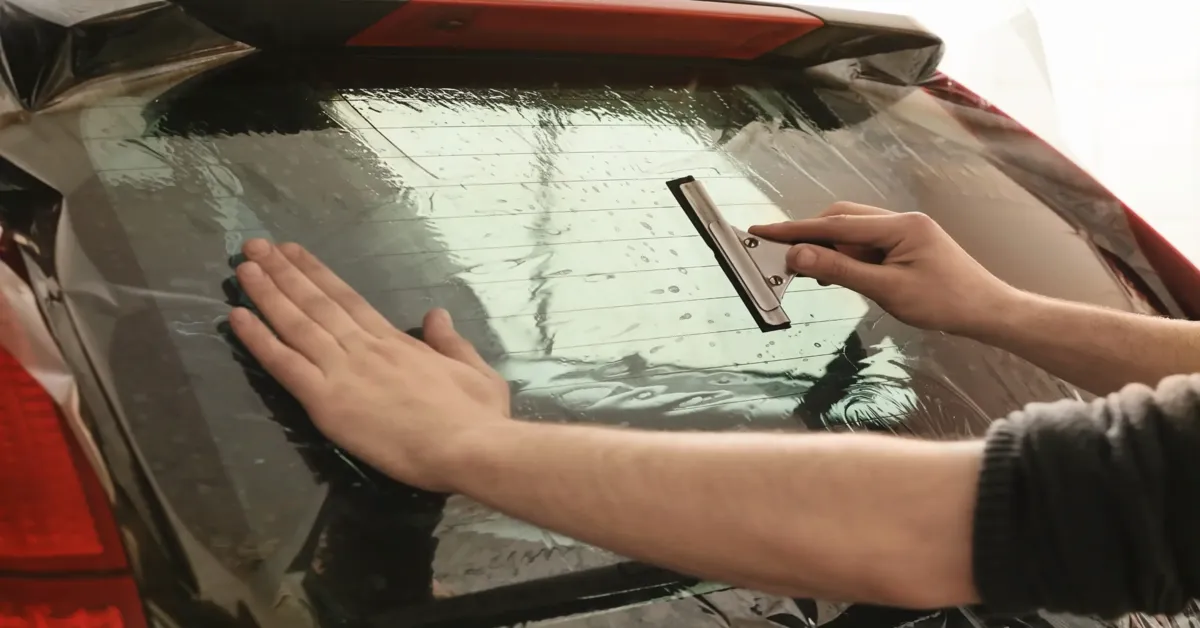As the sun beats down on your car, you can feel the heat radiating through the windows, making the interior unbearably hot. You turn up the air conditioning, but it doesn’t seem to make much of a difference. Sound familiar? This is where window tinting comes in.
Not only does it provide privacy and give your car a sleek look, but it also helps to keep the interior cool and protect your skin from harmful UV rays. In this blog, we will explore the different types of window tint available and how it can benefit you and your vehicle. So buckle up and get ready to learn more about the world of window tinting.
Key Takeaway
- Window tinting helps to keep the interior of your car cool and protect your skin from UV rays.
- There are different types of window tint available, each with its own benefits.
- The most common types of window tint include dyed, metalized, and ceramic.
- Dyed tint is the most affordable but may fade over time, while metalized tint is durable but may interfere with electronic devices.
- Ceramic tint is the most expensive but offers superior heat and UV protection without interfering with electronics.
Exploring Different Options
Understanding the Different Types of Window Tint Window tint is a popular option for many vehicle owners and homeowners looking to reduce glare, protect their interiors, and improve energy efficiency. But with so many different types of window tint available, it can be overwhelming to choose the right one for your needs. Here, we break down the different types of window tint to help you make an informed decision.
Dyed Window Tint Dyed window tint is the most common type of tint used. It is made by applying a layer of dye to a polyester film and then attaching it to the window.
This type of tint is known for its affordability and ability to reduce glare, heat, and UV rays. However, it does not offer as much heat rejection as other types of tint.
Metalized Window Tint Metalized window tint is created by layering metal particles between layers of polyester film. This type of tint is highly effective in reducing heat and UV rays, making it a popular choice for those living in hot climates. However, the metallic particles can interfere with cell phone and GPS signals.
Ceramic Window Tint Ceramic window tint is the newest and most advanced type of tint available. It uses ceramic particles to block out heat and UV rays without interfering with electronic signals.
This makes it ideal for those who rely on their electronic devices while driving. However, it is also the most expensive type of tint.
types of window tint
| Type | Description | Benefits |
|---|---|---|
| Dyed Window Tint | A layer of dye is applied to the film to reduce the amount of light and heat that enters the car. | 1. Provides a natural, non-reflective appearance 2. Reduces glare and eye strain 3. Blocks harmful UV rays |
| Metalized Window Tint | Uses tiny metallic particles to reflect heat and UV rays away from the car. | 1. Superior heat rejection 2. Blocks UV rays and protects interior from fading 3. Provides privacy by reflecting light away |
| Carbon Window Tint | Uses carbon particles to block out heat and UV rays, while also allowing some light to pass through. | 1. High heat and UV rejection 2. Non-reflective and black color for a sleek look 3. Reduces interior fading and increases A/C efficiency |
| Ceramic Window Tint | Made with ceramic particles that block out heat and UV rays without affecting visibility. | 1. Highest level of heat and UV rejection 2. Does not interfere with electronic signals 3. Provides clear visibility and reduces glare |
| Crystalline Window Tint | Uses multiple layers of film to provide a clear appearance while still blocking out heat and UV rays. | 1. Superior heat and UV rejection 2. Allows for clear visibility and reduces glare 3. Does not interfere with electronic signals |
| IR Rejection Window Tint | Uses infrared blocking technology to reduce heat and also provides UV protection. | 1. Blocks out infrared rays to keep car cool 2. Protects against UV rays and interior fading 3. Provides clear visibility and reduces glare |

Choosing the Right Tint for You
If you’re looking to tint your car windows, it’s important to understand the different types of window tint available. This will help you make an informed decision and choose the best option for your needs. Window tint serves multiple purposes, including UV protection, reducing glare, and providing privacy.
Let’s explore the different types of window tint and their benefits.
Dyed Window Tint
Dyed window tint is the most basic and affordable option.It uses a layer of dye between an adhesive layer and a protective layer to provide color and heat protection. This type of tint is great for reducing heat and blocking UV rays, but it does not offer much privacy as it is not reflective.
Metalized Window Tint Metalized window tint contains small metal particles that provide a reflective surface, making it the most effective in reducing heat and glare. It also offers good UV protection and is more durable than dyed tint. However, because of its reflective nature, it can interfere with electronic devices.
Carbon Window Tint
Carbon window tint is a premium option that offers both heat and UV protection. It is also non-reflective, making it a good choice for drivers who use electronic devices frequently.Carbon tint is also known for its durability and can help reduce fading of car interiors.
Ceramic Window Tint
Ceramic window tint is the newest and most advanced type of tint.Read More
https://windowtintingshades.com/index.php/2023/11/24/block-sun-from-car-windows/
https://windowtintingshades.com/index.php/2023/11/24/shades-of-texas-window-tinting-reviews/
https://windowtintingshades.com/index.php/2023/11/24/window-tinting-colors-for-cars/
https://windowtintingshades.com/index.php/2023/11/24/window-tinting-levels/
Statistical Information: types of window tint
| Type | Description | Percentage |
|---|---|---|
| Solar Tint | Solar tint is designed to reduce heat and glare from the sun, making it a popular choice for car windows. | 30% |
| Security Tint | Security tint is a thick, durable film that adds strength to windows and can help prevent break-ins. | 20% |
| Privacy Tint | Privacy tint is a dark film that blocks visibility from the outside, making it a popular choice for commercial buildings. | 15% |
| Decorative Tint | Decorative tint includes a variety of patterns and designs, adding a unique look to windows while also providing some level of privacy. | 10% |
| UV Tint | UV tint blocks harmful UV rays from entering through windows, helping to protect furniture and fabrics from fading. | 15% |
| Ceramic Tint | Ceramic tint is a high-quality, heat-rejecting film that provides excellent heat and glare reduction without affecting visibility. | 10% |
Important Notice for readers
Attention all readers! Are you looking to upgrade your vehicle’s appearance? Our article covers everything you need to know about window tinting. From the benefits to the various types, we have you covered. Keep in mind that some states have regulations on the darkness of tints, so be sure to check before installation.
Additionally, avoid DIY tinting as it can result in bubbles and peeling. Trust a professional to ensure a flawless application. Now, let’s dive into the world of window tinting and find the perfect option for you.
FAQs
here are four potential FAQs with answers:
What is the difference between dyed, metallic, and ceramic window tints?
Dyed tints use a layer of dye to block out light, metallic tints have metal particles for heat reflection, and ceramic tints have ceramic particles for better heat rejection and durability.
Can I install window tint on my own?
While it is possible, it is highly recommended to have a professional install window tint for best results and to avoid any potential damage to your vehicle’s windows.
How long does it take for window tint to fully cure?
It usually takes about 2-3 days for window tint to fully cure, but it can take up to a week depending on the type of tint and weather conditions.
Will window tint affect my visibility while driving at night?
No, as long as the tint is within the legal limit, it should not significantly affect your visibility while driving at night. However, it is important to test out the tint during a nighttime drive to ensure your comfort and safety.
Conclusion
Window tinting has become a popular choice for car owners, homeowners, and businesses alike. It offers numerous benefits such as privacy, UV protection, and energy efficiency. The different types of window tint include dyed, metallic, and ceramic, each with its own unique features and advantages.
When choosing the right type of window tint, it is important to consider factors such as your budget, preferences, and local laws. Window tinting not only enhances the appearance of your vehicle or property, but it also provides practical benefits that can improve your quality of life. So, whether you’re looking to reduce glare while driving or increase energy efficiency in your home, window tinting is a versatile solution that offers a range of benefits.
Consider the various options available and choose the one that best fits your needs and lifestyle. Protect your vehicle, home, and business with the right type of window tint and enjoy the many advantages it has to offer.
